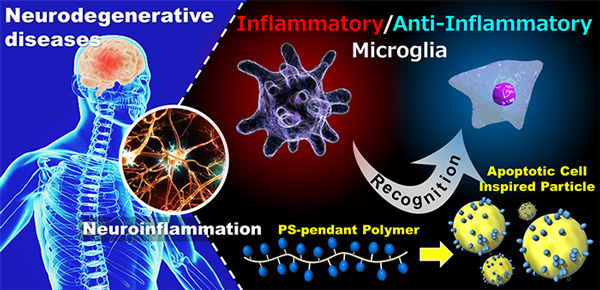- Home
- > Research
- > Research Highlights
- > Vol. 52 Polymeric Particles with Anti-・・・
 Research Highlights
Research Highlights
[Vol. 52]
Polymeric Particles with Anti-Inflammatory Potential for Neurodegenerative Disease Treatment

Figure: Phosphoryl-serine-decorated polymeric particles with anti-inflammatory effect have great potential to be used in novel therapies toward neurodegenerative diseases.
One of the pathological mechanisms observed in neurodegenerative diseases in the central nervous system, including Alzheimer’s and Parkinson’s disease, is the accumulation of so-called microglia — cells that perform functions such as removing dead cells and excess synapses in the brain. When over-activated, microglia can also produce cytokines (small proteins) causing inflammation. Now, Mitsuhiro Ebara at the International Center for Materials Nanoarchitectonics, National Institute for Materials Science, Tsukuba, Japan, and colleagues have synthesized polymeric particles that can suppress microglial inflammation. These particles may be used in novel therapies for neurodegenerative diseases.
The researchers were inspired by behavior seen for apoptotic cells — cells that are dying, in a controlled way, as a natural part of an organism’s development. Microglia can recognize apoptotic cells through the production of a compound called phosphatidylserine. After recognition, microglia produce cytokines that have anti-inflammatory effects.
Ebara and colleagues synthesized amphiphilic random copolymers with phosphoryl serine (PS) groups attached to them; the idea being that such polymers mimic the property of apoptotic cells to counter-act inflammation. They fabricated the polymers in the form of spherical particles (rather than strings), with the PS groups protruding from the particle surface by using hydrophobic effect and self-assembly system.
The scientists then tested the effect of their PS particles on macrophages. (Macrophages are a type of white blood cell that cleans up ‘debris’ in cells.). The PS particles triggered a response from the macrophages, indicating that the particles indeed have an anti-inflammatory effect. Next, they tested the response of the presence of PS particles to microglia in vitro. An uptake of the particles by microglia cells was observed, again a confirmation of their anti-inflammatory potential.
The researchers point out that the finding that PS particles can inhibit inflammatory factors shows the possibility of applying such particles in novel anti-inflammatory therapeutic strategies for neurodegenerative diseases. Moreover, quoting Ebara and colleagues, “the concept of this polymer particle system can also be easily extended to harbor various other types of hydrophobic drugs, thereby showing potential to establish a combinatory therapy with an anti-inflammation material and other drug targets.”
Reference
“Apoptotic Cell-Inspired Polymeric Particles for Controlling Microglial Inflammation toward Neurodegenerative Disease Treatment”
Yasuhiro Nakagawa, Yuto Yano, Jeonggyu Lee, Yasutaka Anraku, Makoto Nakakido, Kouhei Tsumoto, Horacio Cabral, and Mitsuhiro Ebara
Journal : ACS Biomater. Sci. Eng. 5 (2019) 5705−5713.
DOI : 10.1021/acsbiomaterials.8b01510
Yasuhiro Nakagawa, Yuto Yano, Jeonggyu Lee, Yasutaka Anraku, Makoto Nakakido, Kouhei Tsumoto, Horacio Cabral, and Mitsuhiro Ebara
Journal : ACS Biomater. Sci. Eng. 5 (2019) 5705−5713.
DOI : 10.1021/acsbiomaterials.8b01510
Affiliations
International Center for Materials Nanoarchitectonics (WPI-MANA), National Institute for Materials Science (NIMS), Namiki 1-1, Tsukuba, Ibaraki 305-0044, Japan
Contact information
Research Center for Materials Nanoarchitectonics (MANA)
National Institute for Materials Science
1-1 Namiki, Tsukuba, Ibaraki 305-0044 Japan
Phone: +81-29-860-4710
E-mail: mana-pr[AT]nims.go.jp
1-1 Namiki, Tsukuba, Ibaraki 305-0044 Japan
Phone: +81-29-860-4710
E-mail: mana-pr[AT]nims.go.jp

